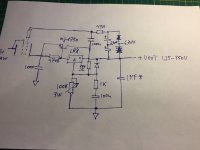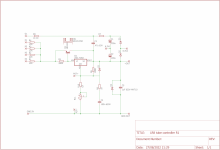Greetings,
I would like to share an idea of mine for a wide adjustment tube regulated bench power supply. Ive tested it, and it works as expected.
My prototype worked flawlessly from 1.25V up to 350V
This idea uses the LR8 IC because of its low minimum output current requirement spec of 0.3mA typ, as opposed to 3.5mA for the LM317(HV) or 15mA Typ for the TL783. this means you dont have to dissipate as much in the output divider.
The IC cannot provide more than 5mA so an external PNP to increase the current capability is utilized , MJE350 was chosen because it was available, but other 200V 1A class of PNP transistors can be used as well, provided its Beta is large enough.
Instead of a resistor plus zener from the raw B+ to the output, im using the heater for the pass tube fed into a voltage doubler and RC filtered. This ensures that the divider current of 3mA or so is enough to guarantee stability.
Cheers,
V4lve
I would like to share an idea of mine for a wide adjustment tube regulated bench power supply. Ive tested it, and it works as expected.
My prototype worked flawlessly from 1.25V up to 350V
This idea uses the LR8 IC because of its low minimum output current requirement spec of 0.3mA typ, as opposed to 3.5mA for the LM317(HV) or 15mA Typ for the TL783. this means you dont have to dissipate as much in the output divider.
The IC cannot provide more than 5mA so an external PNP to increase the current capability is utilized , MJE350 was chosen because it was available, but other 200V 1A class of PNP transistors can be used as well, provided its Beta is large enough.
Instead of a resistor plus zener from the raw B+ to the output, im using the heater for the pass tube fed into a voltage doubler and RC filtered. This ensures that the divider current of 3mA or so is enough to guarantee stability.
Cheers,
V4lve
Attachments
I made a board for this circuit. Schematics, board image and gerbers attached.
If you need these boards, i will order some for my own use and resale.
Cheers,
V4LVE
If you need these boards, i will order some for my own use and resale.
Cheers,
V4LVE
Attachments
The MJ350 DC SOA is 100ma at 100 volts and 10ma at 300 volts.
How much current can this supply provide at 350 volts?
I have done something similar for a regulated screen grid power supply but used a mosfet with a more robust DC SOA
I am interested in a couple boards.
Thanks
Steve
How much current can this supply provide at 350 volts?
I have done something similar for a regulated screen grid power supply but used a mosfet with a more robust DC SOA
I am interested in a couple boards.
Thanks
Steve
The current depends on the pass tube used and the SOA of your choice of PNP transistor. But with the reccomended cooler 10W of dissipation is feasible. This means that if you use for example a tube that sees 50V grid-cathode in operation, 200mA is the maximum current.
If you use pass tubes with a floating screen supply you lower the grid-cathode voltage the regulator sees.
PM if you want boards for this, they are scheduled for delivery next week or so. I can also supply some of the parts.
Cheers,
V4LVE
If you use pass tubes with a floating screen supply you lower the grid-cathode voltage the regulator sees.
PM if you want boards for this, they are scheduled for delivery next week or so. I can also supply some of the parts.
Cheers,
V4LVE
It would be good if it survived a short. Ive a couple of mosfet maida LT3080s but as everyone has pointed out the Maida blows mosfets on a short. Also the mosfet SOA needs a less sensitive older generation to prevent startup failure with any form of HV. I’m using a 900V mosfet with a sub 200V HV and the only other mosfets with compatible SOA in the modern generation are over £30 each..
Thinking in terms of a bench PSU as well as a standard PSU for tube fun.
Thinking in terms of a bench PSU as well as a standard PSU for tube fun.
Over the years I've tried various variable HV circuits that use mosfets and all have eaten fets occasionally despite zener gate source protection, gate resistors etc. Part of the problem is the fets we use are switching fets, not designed for use in linear supplies but when it comes down to it you can't beat a valve as the series pass elements, valves can take abuse that kill solid state devices. You can get linear fets but as Nick points out they ain't cheap. I even tried TO247 packaged 900v SOA fets, result a more expensive fault.
If your testing valves for instance you'll get the odd "super valve", a valve that's gone slightly to air and has a lot higher emission that can't be controlled 100% by the negative grid bias, result dead mosfet. So, screwdriver out, pull the board, swop the fet and any other trannys that have died, after a few times it gets boring. I'm going to use valve based HV variable supplies in my homemade valve tester.
Re your design VL is the valve the sries pass element or is it the valve and the fet? I'm not too up on SS state circuits.
If your testing valves for instance you'll get the odd "super valve", a valve that's gone slightly to air and has a lot higher emission that can't be controlled 100% by the negative grid bias, result dead mosfet. So, screwdriver out, pull the board, swop the fet and any other trannys that have died, after a few times it gets boring. I'm going to use valve based HV variable supplies in my homemade valve tester.
Re your design VL is the valve the sries pass element or is it the valve and the fet? I'm not too up on SS state circuits.
Perhaps a set of floating supplies stacked may be the option to solve a the SOA issue at high voltage.
It seems modern switching mosfets dont like DC operation having been developed for high speed SMPS switching pulses.
So modern mosfet pass device over 30V seems to get expensive and complex. You could just use a 200V BJT and heat sink it to oblivion then stack floating supplies with a opto isolation making the final voltage/current reading.
A 6as7 would give you enough to play with but a large voltage drop.. stacked solid state may be your better option.
As you turn up the voltage, it could power up the next stacked ss power supply and and so on. Just be careful of capacitance and reverse polarity so high voltage diodes (big MURS for example) on each supply would be needed.
I stack 32V and 177V dc supplies already, having a 32V, then 100V stack blocks would work so you have an easy life at 32V or less with lowest noise then as it ramps you add more. It’s also expandable.
It seems modern switching mosfets dont like DC operation having been developed for high speed SMPS switching pulses.
So modern mosfet pass device over 30V seems to get expensive and complex. You could just use a 200V BJT and heat sink it to oblivion then stack floating supplies with a opto isolation making the final voltage/current reading.
A 6as7 would give you enough to play with but a large voltage drop.. stacked solid state may be your better option.
As you turn up the voltage, it could power up the next stacked ss power supply and and so on. Just be careful of capacitance and reverse polarity so high voltage diodes (big MURS for example) on each supply would be needed.
I stack 32V and 177V dc supplies already, having a 32V, then 100V stack blocks would work so you have an easy life at 32V or less with lowest noise then as it ramps you add more. It’s also expandable.
Last edited:
If you can find some old production BUZ80 mosfets, those have good SOA for a TO220. One of my suppliers apparently has hundreds for 50C each.
This circuit uses a LR8 with a MJE350 in parallel to modulate the cathode of the pass tube, you can get 250-300mA out with a EL34 in triode mode operating at 150V anode-cathode.
This circuit uses a LR8 with a MJE350 in parallel to modulate the cathode of the pass tube, you can get 250-300mA out with a EL34 in triode mode operating at 150V anode-cathode.
There is a good article about bench HV power supply at Bartola's: https://www.bartola.co.uk/valves/tag/gu50-right-handed-mode/
It only blows when people try to bypass the IN or ADJ pinsIt would be good if it survived a short. Ive a couple of mosfet maida LT3080s but as everyone has pointed out the Maida blows mosfets on a short.
- Home
- Amplifiers
- Tubes / Valves
- Developing a wide adjustment range Tube bench supply


